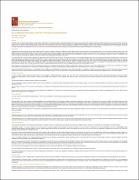| dc.contributor.author | Mabirizi, David | |
| dc.date.accessioned | 2019-02-15T14:14:21Z | |
| dc.date.available | 2019-02-15T14:14:21Z | |
| dc.date.issued | 2004-12 | |
| dc.identifier.issn | 2073-0683 | |
| dc.identifier.uri | http://hdl.handle.net/20.500.12280/1427 | |
| dc.description.abstract | This paper looks at the pervasive problem of low utilisation of health units for maternal and other reproductive health services. It gives one example of how a poorly performing institution made a turn-around and, driven by the need to improve access to, at least, maternal health services, made major strides in improving the quality of all the other services. The paper highlights the fact that relatively simple financial and organisational arrangements (most of which are relatively easy to redress) could be important barriers for the poor. In Nkozi Hospital, user-fees were reduced and flattened, resulting into a very significant increase in both utilisation and hospital revenue. It also highlights the need for community involvement in the planning of services, the need for human resource development and the importance of continued government support to the private-not-for-private sector. | en_US |
| dc.language.iso | en | en_US |
| dc.publisher | Uganda Martyrs University, Department of Health Sciences | en_US |
| dc.rights | Attribution-NonCommercial-NoDerivs 3.0 United States | * |
| dc.rights.uri | http://creativecommons.org/licenses/by-nc-nd/3.0/us/ | * |
| dc.subject | Nkozi Hospital | en_US |
| dc.subject | Hospital Revenue | en_US |
| dc.subject | User-fees | en_US |
| dc.title | Do Affordable Fees Really Matter? The Case of Nkozi Hospital | en_US |
| dc.type | Article | en_US |



